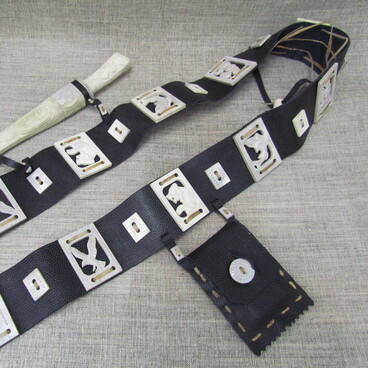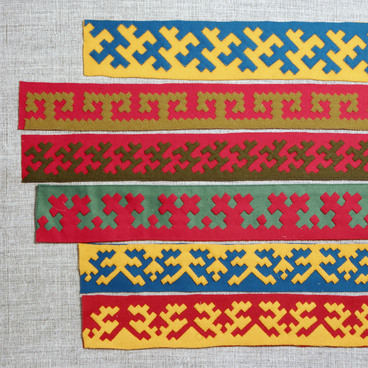The harsh climate of the North of the Western Siberia dictates its terms to local people. One needs here warm windproof fur outfit and footwear fit for a nomadic way of life. Traditional Forest NEnets clothing is made of processed reindeer skins. Different types of clothing require skins of reindeer of different age. The Nenets use reindeer fur since old times because of its excellent thermal qualities.
Only women are engaged in tailoring. The clothing is sewn with threads made of reindeer legs and back tendons. A winter ‘mAlitsa’ coat is a close upper garment with fur inside. The design of this coat is like of a loose knee-long shirt. Every mAlitsa has a doubled hood that serves as a hat for its owner. At the bottom, this coat is edged with a strip of dark fur about twenty centimeters wide. The edging has fur both outside and inside to make the bottom of the coat heavier. Another practical reason is that fur repels snow thus protecting the hem from moisture and prolong the life time of a mAlitsa. Above the edging, three strips of cloth of yellow, green and red color are attached as an additional decoration.
The feature of the Forest Nenets malitsa is a seam in the front. According to many researchers, it proves that earlier a male clothing was of an open type. All main seams including the central one are decorated with strips of red cloth. Mittens made of kamus — a reindeer legs skin — are sewn to the sleeves with fur out. There are slots at the wrist level, so that one could pull out the hands.
A mAlitsa is worn straight on the body. Adjacent to a body, long and hollow reindeer piles create a special microclimate and keep warmth. Fur also absorbs excessive moisture as it touches the skin. Its main upper part always stays clean and keeps preserving warmth.
The fur malitsa in the museum exposition was made by Oksana Ayvasedo, a Khanymey village resident.
Only women are engaged in tailoring. The clothing is sewn with threads made of reindeer legs and back tendons. A winter ‘mAlitsa’ coat is a close upper garment with fur inside. The design of this coat is like of a loose knee-long shirt. Every mAlitsa has a doubled hood that serves as a hat for its owner. At the bottom, this coat is edged with a strip of dark fur about twenty centimeters wide. The edging has fur both outside and inside to make the bottom of the coat heavier. Another practical reason is that fur repels snow thus protecting the hem from moisture and prolong the life time of a mAlitsa. Above the edging, three strips of cloth of yellow, green and red color are attached as an additional decoration.
The feature of the Forest Nenets malitsa is a seam in the front. According to many researchers, it proves that earlier a male clothing was of an open type. All main seams including the central one are decorated with strips of red cloth. Mittens made of kamus — a reindeer legs skin — are sewn to the sleeves with fur out. There are slots at the wrist level, so that one could pull out the hands.
A mAlitsa is worn straight on the body. Adjacent to a body, long and hollow reindeer piles create a special microclimate and keep warmth. Fur also absorbs excessive moisture as it touches the skin. Its main upper part always stays clean and keeps preserving warmth.
The fur malitsa in the museum exposition was made by Oksana Ayvasedo, a Khanymey village resident.




